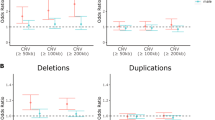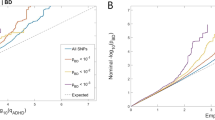Abstract
Genetic and pharmacological studies have emphasised the role of serotonin 5-hydroxytryptamine (5-HT) as a possible etiologic factor in the development of attention-deficit hyperactivity disorder (ADHD). Tryptophan hydroxylase (TPH) is a rate-limiting enzyme in the biosynthesis of serotonin from tryptophan. Originally, the TPH gene was thought to be widely expressed, but a second form of TPH, TPH2, was recently identified and the TPH2 gene was found to be solely expressed in the brain. We examined eight single nucleotide polymorphisms (SNP) in the TPH2 gene for association with ADHD in 179 Irish nuclear families. Transmission disequilibrium test analysis revealed significant association between the T allele of marker rs1843809 with the disorder (χ2=12.2, P=0.0006, OR=2.36). Stratifying data by the sex of the transmitting parent showed that this association was enhanced when paternal transmission was considered (OR=3.7). In addition, several haplotypes (all including the associated marker) were associated with ADHD. These preliminary findings suggest that TPH2 is a susceptibility locus for ADHD. Further confirmation, preferably from different ethnic groups, is required to firmly implicate TPH2 in the pathophysiology of ADHD.
This is a preview of subscription content, access via your institution
Access options
Subscribe to this journal
Receive 12 print issues and online access
$259.00 per year
only $21.58 per issue
Buy this article
- Purchase on Springer Link
- Instant access to full article PDF
Prices may be subject to local taxes which are calculated during checkout

Similar content being viewed by others
References
Tannock R . Attention deficit hyperactivity disorder: advances in cognitive, neurobiological, and genetic research. J Child Psychol Psychiatry 1998; 39: 65–99, Review.
Anderson JC, Williams S, McGee R, Silva PA . DSM-III disorders in preadolescent children. Prevalence in a large sample from the general population. Arch Gen Psychiatry 1987; 44: 69–76.
Levy F, Hay DA, McStephen M, Wood C, Waldman I . Attention-deficit hyperactivity disorder: a category or a continuum? Genetic analysis of a large-scale twin study. J Am Acad Child Adolesc Psychiatry 1997; 36: 737–744.
Thapar A, Holmes J, Poulton K, Harrington R . Genetic basis of attention deficit and hyperactivity. Br J Psychiatry 1999; 174: 105–111.
Faraone SV, Biederman J . Neurobiology of attention-deficit hyperactivity disorder. Biol Psychiatry 1998; 44: 951–958.
Lucki I . The spectrum of behaviors influenced by serotonin. Biol Psychiatry 1998; 44: 151–162.
Halperin JM, Newcorn JH, Schwartz ST, Sharma V, Siever LJ, Koda VH et al. Age-related changes in the association between serotonergic function and aggression in boys with ADHD. Biol Psychiatry 1997; 41: 682–689.
Gainetdinov RR, Wetsel WC, Jones SR, Levin ED, Jaber M, Caron MG . Role of serotonin in the paradoxical calming effect of psychostimulants on hyperactivity. Science 1999; 283: 397–401.
Grahame-Smith DG . Tryptophan hydroxylation in brain. Biochem Biophys Res Commun 1964; 16: 586–592.
Walther DJ, Peter JU, Bashammakh S, Hortnagl H, Voits M, Fink H et al. Synthesis of serotonin by a second tryptophan hydroxylase isoform. Science 2003; 299: 76.
Zill P, Buttner A, Eisenmenger W, Bondy B, Ackenheil M . Regional mRNA expression of a second tryptophan hydroxylase isoform in postmortem tissue samples of two human brains. Eur Neuropsychopharmacol 2004; 14: 282–284.
Tang G, Ren D, Xin R, Qian Y, Wang D, Jiang S . Lack of association between the tryptophan hydroxylase gene A218C polymorphism and attention-deficit hyperactivity disorder in Chinese Han population. Am J Med Genet 2001; 105: 485–488.
Li J, Wang YF, Zhou RL, Yang L, Zhang HB, Wang B . Association between tryptophan hydroxylase gene polymorphisms and attention deficit hyperactivity disorder with or without learning disorder. Zhonghua Yi Xue Za Zhi 2003; 83: 2114–2118 [Article in Chinese with English summary].
Kirley A, Lowe N, Mullins C, McCarron M, Daly G, Waldman I et al. Phenotype studies of the DRD4 gene polymorphisms in ADHD: association with oppositional defiant disorder and positive family history. Am J Med Genet 2004; 131B: 38–42.
Angold A, Prendergast M, Cox A, Harrington R, Simonoff E, Rutter M . The Child and Adolescent Psychiatric Assessment (CAPA). Psychol Med 1995; 25: 739–753.
Holmes J, Lawson D, Langley K, Fitzpatrick H, Trumper A, Pay H et al. The child attention-deficit hyperactivity disorder teacher telephone interview (CHATTI): reliability and validity. Br J Psychiatry 2004; 184: 74–78.
Ward MF, Wender PH, Reimherr FW . The Wender Utah rating scale: an aid in the retrospective diagnosis of childhood attention deficit hyperactivity disorder. Am J Psychiatry 1993; 150: 885–890.
Gill M, Daly G, Heron S, Hawi Z, Fitzgerald M . Confirmation of association between attention deficit hyperactivity disorder and a dopamine transporter polymorphism. Mol Psychiatry 1997; 2: 311–313.
Norton N, Williams NM, Williams HJ, Spurlock G, Kirov G, Morris DW et al. Universal, robust, highly quantitative SNP allele frequency measurement in DNA pools. Hum Genet 2002; 110: 471–478.
Spielman RS, McGinnis RE, Ewens WJ . Transmission test for linkage disequilibrium: the insulin gene region and insulin-dependent diabetes mellitus (IDDM). Am J Hum Genet 1993; 52: 506–516.
Zill P, Baghai TC, Zwanger P, Schule C, Eser D, Rupprecht R et al. SNP and haplotype analysis of a novel tryptophan hydroxylase isoform (TPH2) gene provide evidence for association with major depression. Mol Psychiatry 2004; 9: 1030–1036.
Zill P, Buttner A, Eisenmenger W, Moller HJ, Bondy B, Ackenheil M . Single nucleotide polymorphism and haplotype analysis of a novel tryptophan hydroxylase isoform (TPH2) gene in suicide victims. Biol Psychiatry 2004; 56: 581–586.
Rapoport J, Quinn P, Scribanu N, Murphy DL . Platelet serotonin of hyperactive school age boys. Br J Psychiatry 1974; 125: 138–140.
Kleinjan DA, van Heyningen V . Long-range control of gene expression: emerging mechanisms and disruption in disease. Am J Hum Genet 2005; 76: 8–32.
Kumer SC, Mockus SM, Rucker PJ, Vrana KE . Amino-terminal analysis of tryptophan hydroxylase: protein kinase phosphorylation occurs at Serine-58. J Neurochem 1997; 69: 1738–1745.
Veenstra-VanderWeele J, Cook Jr EH . Knockout mouse points to second form of tryptophan hydroxylase. Mol Interv 2003; 3: 72–75.
Zhang X, Beaulieu JM, Sotnikova TD, Gainetdinov RR, Caron MG . Tryptophan hydroxylase-2 controls brain serotonin synthesis. Science 2004; 305: 217.
Posner MI, Petersen SE . The attention system of the human brain. Annu Rev Neurosci 1990; 13: 25–42.
Aston-Jones G, Rajkowski J, Cohen J . Role of locus coeruleus in attention and behavioral flexibility. Biol Psychiatry 1999; 46: 1309–1320.
Vu TH, Hoffman AR . Comparative genomics sheds light on mechanisms of genomic imprinting. Genome Res 2000; 10: 1660–1663.
Acknowledgements
We acknowledge the generous support of the Health Research Board, Dublin (KS, NL, ZH), the Dublin Molecular Medicine Centre for ZH and the Hyperactive and Attention Disorder (HAD) Group Ireland. We also thank the families that participated in the study.
Author information
Authors and Affiliations
Corresponding author
Rights and permissions
About this article
Cite this article
Sheehan, K., Lowe, N., Kirley, A. et al. Tryptophan hydroxylase 2 (TPH2) gene variants associated with ADHD. Mol Psychiatry 10, 944–949 (2005). https://doi.org/10.1038/sj.mp.4001698
Received:
Revised:
Accepted:
Published:
Issue Date:
DOI: https://doi.org/10.1038/sj.mp.4001698
Keywords
This article is cited by
-
Association of TPH1 and TPH2 Gene Polymorphisms with the Risk of Developing Psychoneurological Disorders
Neuroscience and Behavioral Physiology (2022)
-
Association of tryptophan hydroxylase-2 polymorphisms with oppositional defiant disorder in a Chinese Han population
Behavioral and Brain Functions (2016)
-
Serotonin Transporter and Tryptophan Hydroxylase Gene Variations Mediate Working Memory Deficits of Cocaine Users
Neuropsychopharmacology (2015)
-
Deficient serotonin neurotransmission and depression-like serotonin biomarker alterations in tryptophan hydroxylase 2 (Tph2) loss-of-function mice
Molecular Psychiatry (2012)
-
Tryptophan hydroxylase2 gene polymorphisms predict brain serotonin synthesis in the orbitofrontal cortex in humans
Molecular Psychiatry (2012)



